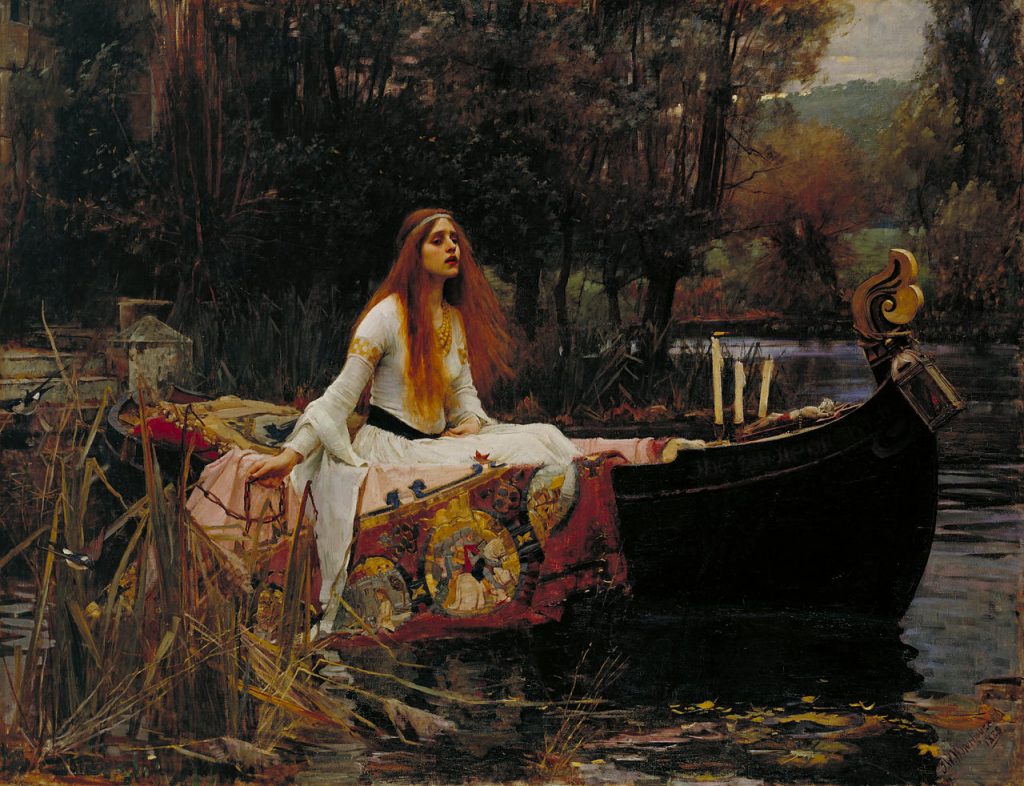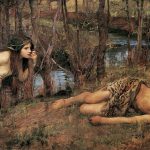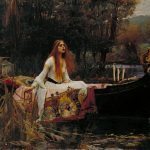
The Lady of Shalott is one of the most haunting and enigmatic figures in both art and literature. Originating in Alfred, Lord Tennyson’s 1832 poem, this tragic character has captivated generations, emerging as a symbol of isolation, unfulfilled desire, and melancholy. Through the visual interpretations of artists—particularly the Pre-Raphaelites—the Lady of Shalott’s story transcends words, becoming a striking icon of romantic tragedy. These artists captured her forbidden love, her cursed existence, and her ultimate fate, giving her story a lasting place in art history.
Tennyson’s Poetic Foundation and Its Artistic Legacy
The story of the Lady of Shalott begins with Alfred, Lord Tennyson’s poem, which narrates the tale of a cursed woman isolated in a tower near Camelot. Forbidden to look directly upon the outside world, she weaves a tapestry, watching life pass through the reflection in a mirror. Her fate changes when she glimpses Sir Lancelot, and in a moment of longing, she turns to look at him, sealing her doom. Tennyson’s vivid imagery and tragic narrative provided rich inspiration for artists who transformed his words into powerful visual expressions.
Victorian artists, inspired by Tennyson’s lush language, found in the Lady of Shalott an ideal subject. Her story of confinement and forbidden desire echoed societal themes, particularly regarding the roles and limitations imposed upon women. Tennyson’s poem opened the door for artists to explore her character’s complexity, her sorrow, and her defiance through color, composition, and symbolism.
The Pre-Raphaelite Brotherhood and Their Fascination with the Lady of Shalott
The Pre-Raphaelite Brotherhood—a group of 19th-century British artists—was instrumental in bringing the Lady of Shalott’s image to life. Known for their elaborate detail, intense color palettes, and emotional depth, these artists aimed to return to the styles of early Renaissance painters. The Lady of Shalott’s tragic and mysterious nature fit perfectly within their aesthetic, inspiring multiple representations that emphasize her beauty, isolation, and ultimate fate.
Among the most famous works is John William Waterhouse’s 1888 painting, “The Lady of Shalott.” This piece portrays her sitting in a boat, surrounded by her woven tapestry, as she drifts toward Camelot. Waterhouse captures a sense of resignation and sorrow in her expression, conveying the depth of her character’s despair. This painting, among others by Pre-Raphaelite artists like Dante Gabriel Rossetti and William Holman Hunt, solidified the Lady’s image as a haunting figure forever bound by her curse.
The Mirror as a Symbol of Isolation and Longing
One of the most potent symbols in the Lady of Shalott’s story is the mirror, which allows her to see the outside world without directly engaging with it. In art, the mirror often represents both a protective boundary and a prison, reflecting her separation from society and her desire to break free. This symbol resonates with Victorian themes of confinement, especially the limited freedoms experienced by women.
Artists frequently depict the mirror as cracked or shattered at the moment she turns to look at Lancelot, a choice that visually emphasizes her defiance and the breaking of her confined reality. In William Holman Hunt’s 1886 version of “The Lady of Shalott,” the mirror plays a central role, reflecting her tragic moment of transgression. This shattering reflects the cost of her desire for freedom, echoing the high price of breaking societal expectations.
The Tapestry: A Symbol of Creation and Confinement
The tapestry the Lady weaves is another key symbol that artists use to explore her dual existence. The tapestry represents both her creative outlet and the limitations of her world, as she creates a version of reality that she cannot physically experience. This imagery resonated strongly with Victorian artists, who often associated women with domestic crafts like weaving and sewing, both seen as forms of expression and restriction.
In Waterhouse’s “I Am Half-Sick of Shadows, Said the Lady of Shalott” (1894), the Lady is depicted at her loom, surrounded by the colorful threads of her tapestry, yet visibly weary of her isolation. This painting captures the tension between her creative act and her growing dissatisfaction with her limited life, emphasizing the tapestry as both her artistic creation and her prison. Through these depictions, artists underscore the theme of confinement inherent in her story.
Sir Lancelot as a Distant Symbol of Desire
Sir Lancelot’s appearance in the Lady of Shalott’s mirror catalyzes her tragic fate. He represents freedom, love, and the life beyond her tower that she so desperately longs for. Artists often portray him as a distant, almost otherworldly figure, underscoring the unattainable nature of her desire. His image embodies the allure of a world she can observe but never fully join.
In several paintings, Lancelot’s reflection in the mirror is depicted with a radiant glow or shining armor, emphasizing his role as an idealized and unreachable figure. His presence highlights the Lady’s deep loneliness and her yearning to escape her confined life. This distant portrayal of Lancelot speaks to the broader theme of unfulfilled desires and the consequences of reaching for something just beyond one’s grasp.
The Final Journey Down the River: Tragic and Poetic
One of the most haunting scenes in the Lady of Shalott’s story is her final journey down the river toward Camelot. This moment has been vividly depicted by artists who emphasize its poetic, tragic beauty. Often, she is shown lying serenely in a boat, draped in her tapestry, as she drifts toward her death. This visual reinforces the theme of freedom attained through tragic means, symbolizing her escape from confinement at a great cost.
In Waterhouse’s “The Lady of Shalott” (1888), her expression as she floats down the river is one of calm resignation, adding to the haunting impact of the scene. The muted tones and somber colors surrounding her enhance the sense of inevitability, as she succumbs to the curse. Her final journey, immortalized in these paintings, represents both her ultimate defiance and her tragic fate, resonating with audiences as a symbol of sacrifice and loss.
The Evolution of the Lady of Shalott’s Image in Modern Art
The Lady of Shalott continues to inspire modern artists, who reinterpret her story to reflect contemporary themes of isolation, desire, and autonomy. Her image has been adapted into paintings, illustrations, and digital art, with each new interpretation highlighting different aspects of her complex narrative. Some modern artists see her as a symbol of societal pressures, reflecting the ongoing struggle for individual freedom and self-expression.
In contemporary works, the Lady’s story is sometimes reimagined to critique social norms, with her curse representing societal constraints that restrict personal growth and freedom. Her enduring image serves as a poignant reminder of the costs of confinement and the timeless appeal of seeking one’s own path. Through these modern adaptations, her legacy remains alive, continuing to resonate with audiences who find new meanings in her tale of longing and defiance.
Conclusion
The Lady of Shalott endures as one of the most evocative figures in art, her story immortalized through the works of the Pre-Raphaelites and artists beyond. From her life of isolation in the tower to her doomed journey down the river, each visual interpretation adds layers of depth to her tragic tale. Through symbols such as the mirror, the tapestry, and the river journey, artists have captured the essence of her character and her story, giving her an enduring place in art history. Today, the Lady of Shalott remains a symbol of yearning, beauty, and tragedy, resonating across generations and artistic styles.
Key Takeaways
- The Lady of Shalott is an iconic figure in art, symbolizing themes of isolation, forbidden love, and tragic beauty.
- Pre-Raphaelite artists like John William Waterhouse brought her story to life with rich symbolism, capturing her confinement, desire, and fate.
- The mirror and tapestry serve as key symbols of her isolation and creativity, reflecting her inner conflict and limitations.
- Sir Lancelot’s role in her story emphasizes unattainable freedom and the cost of forbidden desire.
- Modern interpretations of her story highlight ongoing themes of autonomy, confinement, and self-expression.
FAQs
- Who painted the most famous depiction of the Lady of Shalott?
John William Waterhouse’s 1888 painting, “The Lady of Shalott,” is the most iconic representation of her story. - What do the mirror and tapestry symbolize in the Lady of Shalott’s story?
The mirror represents her isolation, while the tapestry reflects her creativity and limited interaction with the world. - Why is Sir Lancelot significant in depictions of the Lady of Shalott?
Lancelot embodies the freedom and connection she longs for, ultimately sparking her tragic defiance. - How did the Pre-Raphaelite Brotherhood influence depictions of the Lady of Shalott?
They emphasized elaborate detail and emotional depth, transforming her story into a visually powerful symbol of romantic tragedy.



